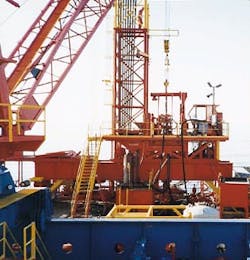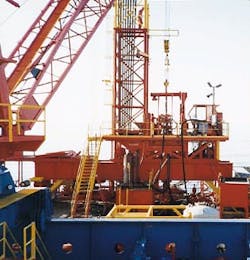Drilling & Production
Rick Von Flatern
Houston
The compact Master Lift Rigless System is designed to lower workover expenses by reducing mobilization and demobilization time and requiring dayrates lower than traditional workover rigs.
Industry future tied to IT
Daniel Yergin, author of The Prize and president of Cambridge Energy Research Associates, has the ear of oil executives worldwide. So when results of a six-month study he chaired on the impact of information technology (IT)on E&P companies was released, industry took note.Since three of the four sponsors - Landmark Graphics, Silicon Graphics, and Oracle Energy - have a more than passing interest in the study's subject, CERA's good name was essential to the work's credibility. Their presence also tempered effects of statements such as those made by Landmark president Robert Peebler, who said the future belonged not to asset-based but to knowledge-based operators.
But Peebler's enthusiasm is easily understood. IT, in the guise of 3D, MWD, and real-time data transmission, has tamed the effects of remoteness, cost, risk, and low commodity prices. Without question, information management is the biggest factor in the industry's ongoing recovery.
Quiet Revolution, as the report is titled, is an important read about the Information Age and its reshaping of the oil and gas business. Among the report's 15 specific findings: the oil and gas business is behind other IT-user industries because E&P companies tend to hang onto dated equipment and software; a not unexpected generation gap that exists between younger workers, comfortable with the new technology, and their elders, who suffer "digital anxiety" has created a data management crisis which time alone will not cure; and though far superior in many ways, client/server computing disappoints many operators who find it costs four times as much as the old mainframe systems E&P companies once used.
If for no other reason than to learn the meaning of terms like change fatigue, wetware, woven world, strongholds, and coral islands, E&P managers, for and to whom the report is written, would do well to secure a copy of Quiet Revolution through Carolyn Hale at (617) 441-2632 or fax (617) 497-0423.
More ultradeep considerations
Plans have been formed, and significant amounts of money committed, preparing to drill for oil and gas in the 10,000-ft water-depth range. The keels of at least two new, multimillion-dollar, dynamic positioning vessels are being laid, alliances struck, and drilling locations picked. But even as intrepid companies move into these frontiers, new questions arise.
The surface and subsurface environments of the Gulf of Mexico and West of the Shetlands, according to Drilling & Marine Technology & Supply president Jim Davis, present the new DP3 vessels with some real challenges to year-round operations. The Gulf Stream flows in a circular pattern around the US Gulf coast and is pierced by major river flows, generally southward from the continental US. In the North Sea a similar 90 degree angle is formed at the confluence of the Gulf Stream and the prevailing northwestern winter current. The effects of these forces are exacerbated by sudden water depth changes at their confluence.
To operate in these conditions, Davis said, dynamic positioning vessels of the size being considered, will require 80,000 kw total available power. Two DP ships currently under construction for Reading & Bates/Conoco and Transocean include 32 kw and 50 kw powerplants respectively. If Davis is correct, upgrading the power, and the larger thrusters they serve, would prove quite expensive.
But power upgrades, however troublesome or expensive, are a routine technical hurdle. Not so other deepwater unknowns. For instance, it remains to be seen what will happen when a 21-in., two-mile riser is disengaged from a subsea wellhead while the ship is at the end of its operational radius, as far from centered over the wellhead as it can operate. When the ship and wellhead are at this maximum horizontal distance from each other, the riser is in a bending moment and release of the bottom end will undoubtedly cause it to move upward before falling back towards the ocean floor. This whipping action could result in a pipe break and subsequent loss of a substantial section of the riser. Downtime and cost of replacement would be significant, especially since it is unlikely extra riser will be stowed on ultradeep water rigs whose deck space is already at a premium. The concern is certainly valid since wellhead disengagement will be as common an operational necessity in deepwater operations as it is currently in shallower waters.
Smaller, cheaper, and faster
In the face of rising rig mobilization and daily costs, discretionary projects such as recompletions or workovers must sometimes be canceled as uneconomic. But platform abandonment is not a discretionary operation and as offshore fields worldwide continue to mature, these occasionally high-profile, often costly, operations will command a growing slice of operators' budgets.
Investigating opportunities in this burgeoning market has led one US service company to draw from it various divisions to create a compact, high capacity lift system without a drawworks and tower. The centerpiece of the Weatherford Enterra product is an 8 ft x 25 ft, 400,000 lb lift capacity "hydrofloor" that facilitates construction of a unit with a footprint far smaller than traditional workover rigs. The entire system can be mobilized on the deck of a single 180-ft workboat for $20,000-$30,0000. Called the Master Lift Rigless System, it can be rigged up or down in about eight hours on platforms with or without cranes.
The hydrofloor includes a standard API drilling table that can accommodate up to 42-in. casing and pulls the casing or tubing in 8-ft strokes until the pull weight is at or below crane capacity. At that point it is pulled and laid down by the existing platform crane or one supplied as an integral part of the unit. What amounts to a miniature iron roughneck - hydraulic tongs that can move in and out of position on rails - can be operated by one person.
Two Gulf of Mexico operators reported 35-40% savings over estimated traditional rig costs while performing slot reclamations and P&A operations with the rigless system. A second unit, currently under construction, will be designed with a top drive to replace the current 25-ft kelly.
Copyright 1997 Offshore. All Rights Reserved.

